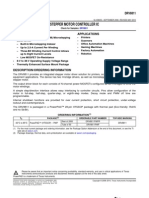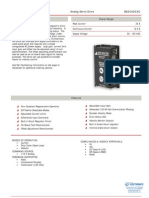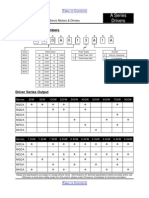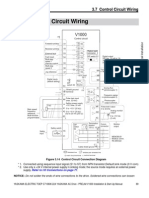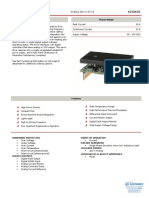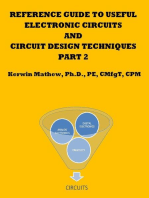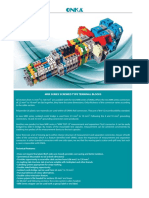0 ratings0% found this document useful (0 votes)
186 views217 3367 JaguarDatasheet
217 3367 JaguarDatasheet
Uploaded by
Yi Cong HuangThe Jaguar motor controller module provides variable speed control for 12V and 24V brushed DC motors up to 40A continuous current. It includes high performance CAN networking and a rich set of control options and sensor interfaces like analog, encoder inputs, and limit switches. The module uses a 32-bit microcontroller and optimized software to implement open and closed loop speed/position/current control of motors.
Copyright:
© All Rights Reserved
Available Formats
Download as PDF, TXT or read online from Scribd
217 3367 JaguarDatasheet
217 3367 JaguarDatasheet
Uploaded by
Yi Cong Huang0 ratings0% found this document useful (0 votes)
186 views16 pagesThe Jaguar motor controller module provides variable speed control for 12V and 24V brushed DC motors up to 40A continuous current. It includes high performance CAN networking and a rich set of control options and sensor interfaces like analog, encoder inputs, and limit switches. The module uses a 32-bit microcontroller and optimized software to implement open and closed loop speed/position/current control of motors.
Original Description:
FRC JAGUAR
Original Title
217-3367-JaguarDatasheet
Copyright
© © All Rights Reserved
Available Formats
PDF, TXT or read online from Scribd
Share this document
Did you find this document useful?
Is this content inappropriate?
The Jaguar motor controller module provides variable speed control for 12V and 24V brushed DC motors up to 40A continuous current. It includes high performance CAN networking and a rich set of control options and sensor interfaces like analog, encoder inputs, and limit switches. The module uses a 32-bit microcontroller and optimized software to implement open and closed loop speed/position/current control of motors.
Copyright:
© All Rights Reserved
Available Formats
Download as PDF, TXT or read online from Scribd
Download as pdf or txt
0 ratings0% found this document useful (0 votes)
186 views16 pages217 3367 JaguarDatasheet
217 3367 JaguarDatasheet
Uploaded by
Yi Cong HuangThe Jaguar motor controller module provides variable speed control for 12V and 24V brushed DC motors up to 40A continuous current. It includes high performance CAN networking and a rich set of control options and sensor interfaces like analog, encoder inputs, and limit switches. The module uses a 32-bit microcontroller and optimized software to implement open and closed loop speed/position/current control of motors.
Copyright:
© All Rights Reserved
Available Formats
Download as PDF, TXT or read online from Scribd
Download as pdf or txt
You are on page 1of 16
B O A R D D A T A S H E E T
Jaguar Motor Controller (217-3367) 1
Jaguar Motor Controller (Stellaris Brushed
DC Motor Control Module with CAN) 217-3367
Ordering Information
Contents
General Description ....................................... 1
Overview ................................................... 2
Detailed Features ...................................... 2
Operational Specifications ........................... 4
Servo-style PWM Input .............................. 8
Electrical Interface ..................................... 8
Power Supply ............................................ 8
Motor Selection ......................................... 9
Operating Modes ....................................... 9
Default Parameters .................................. 10
Wiring ...................................................... 10
Mechanical Details .................................. 11
Status LED .............................................. 12
Jumper Settings ...................................... 12
Fault Detection ........................................ 13
Calibration ............................................... 13
CAN Communication ............................... 13
Coast/Brake Input .................................... 14
Analog Input ............................................ 15
Encoder Input .......................................... 15
Limit Switch Inputs .................................. 16
Firmware Update ..................................... 16
Additional Information ................................ 16
General Description
The Jaguar motor control module is a variable speed control for 12 V and 24 V
brushed DC motors at up to 40 A continuous current. The motor control module includes
high performance CAN networking as well as a rich set of control options and sensor
interfaces, including analog and quadrature encoder interfaces.
The high-frequency pulse width modulator (PWM) enables the DC motor to run smoothly
and quietly over a wide speed range. The Jaguar uses highly optimized software and
Product No. Description
217-3367
Stellaris Brushed DC Motor Control
Module with CAN (217-3367) for
Single-Unit Packaging
3.50"
2.00
4.25
3.85
1.99"
0.175
Figure 1. Brushed DC Motor Control
Module
Figure 2. Mechanical Drawing
Jaguar Motor Controller (217-3367) 2
B O A R D D A T A S H E E T
a powerful 32-bit Stellaris microcontroller to implement open-loop speed control as well as
closed-loop control of speed, position, or motor current.
The Jaguar is a Stellaris reference design. The Brushed DC Motor Control Reference
Design Kit (RDK) contains an Jaguar motor control module as well as additional
hardware and software for evaluating CAN communication. After evaluating the
RDK, users may choose to either customize the parts of the hardware and software
design or use the Jaguar without modification. For detailed circuit-level information
and reference design kit details, see the Brushed DC Motor Control Reference Design Kit
(RDK) User's Manual (available for download from www.ti.com/rdk-bdc24). Use the
Jaguar Getting Started Guide if you are using the Jaguar without modification
Figure 2 shows the Jaguar motor control module from the top view.
Figure 2. Jaguar Motor Controller
Overview
The Jaguar motor control board provides the following features:
Controls brushed 12 V and 24 V DC motors up to 40 A continuous
Controller Area Network (CAN) interface at 1 Mbit/s
Industry-standard servo (PWM) speed input interface
RS232 to CAN bridge
Limit switch, encoder, and analog inputs
Fully enclosed module includes cooling fan
Flexible configuration options with simple source file modification
Easy to customizefull source code and design files available
Detailed Features
This section describes the Jaguars features in detail:
Quiet control of brushed DC motors
15 kHz PWM frequency
Jaguar Motor Controller (217-3367) 3
B O A R D D A T A S H E E T
Three options for Speed control
Industry-standard R-C servo type (PWM) interface
Controller Area Network (CAN) interface
RS232 serial interface
CAN communication
Multicast shared serial bus for connecting systems in electromagnetically noisy
environments
1M bits/s bit rate
CAN protocol version 2.0 A/B
Full configurability of module options
Real-time monitoring of current, voltage, speed, and other parameters
Firmware update
RS232 serial communication
Bridges RS232 port to a CAN network
Directly interfaces to a PC serial port or National Instruments cRIO
Automatic Output Ramp mode
Status LED indicates Run, Direction, and Fault conditions
Motor brake/coast selector
Limit switch inputs for forward and reverse directions
Quadrature encoder input (QEI)
Index input
5 V supply output to encoder
Analog input
Accepts 10 k potentiometer or 0-3 V input
Screw terminals for all power wiring
Headers (0.1 inch pitch) for all control signals
Jaguar Motor Controller (217-3367) 4
B O A R D D A T A S H E E T
Figure 3. Detailed Drawing of the Jaguar Motor Control Module
Operational Specifications
The following tables provide the operation specifications for the Jaguar motor control
board.
WARNING Do not exceed the maximum supply voltage of 30 V
DC
. Doing so will cause permanent
damage to the module.
Table 1. Power Supply
Parameter Min Typ Max Units
Supply voltage range (V
IN
) 5.5
a
a. Power supply requires V
IN
7.0 V
DC
to start up.
12/24 30 Vdc
Supply voltage absolute maximum 35
b
b. Exceeding this limit, even momentarily, will cause permanent damage.
Vdc
Supply current (motor off, fan off) (V
IN
= 12 V) 35 mA
Supply current (motor off, fan on) (V
IN
= 12 V) 105 mA
Under-voltage detect threshold 6.0 Vdc
Motor
Out
( ) Motor
(+) Motor
( ) In
(+) In
From Power
Distribution
Module
Motor output is not protected
against short - circuits.
User Switch
Use hooks to prevent
wires shaking loose
Maintain 0.5" clearance
around all vents
Status LED
Mounting holes
3.50 " centers
Motor coast / brake jumper
Maintain 0.5 " clearance
around all vents
For power wiring use
12AWG Wire with # 6 ring
or spade terminals
CAN Port
6P6C CAN/RS232 Port
Analog input (0-3V)
Encoder Input
Limit switch inputs
Jaguar Motor Controller (217-3367) 5
B O A R D D A T A S H E E T
Table 2. Motor Output
Parameter Min Typ Max Units
Motor voltage
a
a. The motor voltage is controlled by using a pulse-width modulated waveform.
0 V
IN
V
Motor current - continuous 40 A
Motor current for 2 seconds 60 A
Motor current peak at starting 100 A
PWM frequency 15.625 kHz
PWM resolution 0.1 %
Output current for resistive loads
b
b. The output current for resistive loads is continuous and the value shown is the maximum value.
30 A
Table 3. Environment
Parameter Min Typ Max Units
Operating temperature range 0 50 C
Storage temperature range -25 85 C
Fan on temperature 42 C
Fan off temperature 38 C
Table 4. Servo-Style Speed Input
Parameter Min Typ Max Units
Minimum pulse width
a,b
a. Sets full-speed in reverse.
b. These are the default values. Pulse-width range can be calibrated for different values. See the servo
PWM calibration procedure on page 13.
0.67 ms
Neutral pulse width
b
1.5 ms
Maximum pulse width
b,c
c. Sets full-speed in forward direction.
2.33 ms
Servo signal period 5.0125 29.985 ms
Valid pulse width range 0.5 2.50625 ms
Duty cycle range 50 %
Digital high-level input current 2 5 25 mA
Digital low-level input current 0.3 mA
Watchdog time-out 100 ms
Voltage isolation (servo+/- to other signals)
d
d. The servo input is optically isolated.
40 V
Jaguar Motor Controller (217-3367) 6
B O A R D D A T A S H E E T
Table 5. Analog Input
Parameter Min Typ Max Units
Analog input voltage 0 3 V
Potentiometer value 10 k
Potentiometer reference voltage (+ pin)
a
2.9 3.0 3.1 V
Measurement resolution 10-bit bits
Measurement rate 15.625 kHz
a. With 10 k potentiometer connected.
Table 6. Voltage, Current, and Temperature Measurement
Parameter Min Typ Max Units
Temperature measurement accuracy +/- 6 C
Supply voltage measurement accuracy +/- 0.3 V
Motor current measurement accuracy 8A +/- 1 A
Motor current measurement accuracy < 8A +/- 2 A
Measurement resolution 10 bits
Measurement rate 15.625 kHz
Table 7. Brake/Coast Input
Parameter Min Typ Max Units
Digital low-level input voltage
a
a. Selects Brake mode.
-0.3 1.3 V
Digital high-level input voltage
b
b. Selects Coast mode.
2.0 3.3 5.0 V
Digital input pull-down resistor 200 k
Response time 64 s
Power on Pin 1 (3.3 V) 25 mA
Table 8. Quadrature Encoder Input (QEI)
Parameter Min Typ Max Units
Digital low-level input voltage
a
-0.3 1.3 V
Digital high-level input voltage
a
2.0 3.3 5.0 V
Digital input pull-up resistor 10 k
Encoder rate
b
DC 1 M
Encoder supply voltage 4.90 5.0 5.10 V
Jaguar Motor Controller (217-3367) 7
B O A R D D A T A S H E E T
Encoder supply current 100 mA
a. Applies to A, B, and Index inputs.
b. Measured in transitions per second.
Table 9. CAN Interface
Parameter Min Typ Max Units
Bit rate 0.0133
a
a. Limited by fail-safe CAN transceiver SN65HVD1050.
1 1 Mbps
Recommended bus termination
b
b. Two terminations per network.
100
Absolute maximum CANH, CANL voltage -27 40 V
Watchdog time-out 100 ms
Number of nodes per network
c
(protocol limit)
c. Must be a valid ID range.
1 63 #
Number of nodes per network (physical limit) 1 16 #
Total cable length
20
6.1
ft
m
Table 10. RS232 Interface
Parameter Min Typ Max Units
Baud rate 115,200 Baud
Format 8, n, 1
Watchdog time-out 100 ms
RXD Absolute Maximum Voltage Range -25 +25 V
TXD High-level output voltage 5 5.4 V
TXD Low-level output voltage -5 -5.4 V
RXD Positive-going threshold 1.9 V
RXD Negative-going threshold 1.4 V
Table 11. Limit Switch Interface
Parameter Min Typ Max Units
Digital low-level input voltage
a
-0.3 1.3 V
Digital high-level input voltage
b
2.0 3.3 5.0 V
Pull-up resistor 10 k
Table 8. Quadrature Encoder Input (QEI) (Continued)
Parameter Min Typ Max Units
Jaguar Motor Controller (217-3367) 8
B O A R D D A T A S H E E T
Servo-style PWM Input
The Jaguar incorporates support for speed and direction control using the standard
servo-style interface found on many radio-control receivers and robot controllers. See the
electrical specifications for default timing of this signal.
Electrical Interface
The Servo PWM input is electrically isolated from other circuits using an optocoupler. The Jaguar
datasheet contains electrical specifications, including common-mode voltage
limits, for the input stage.
Figure 4. Jaguar's Servo PWM Input Stage
The on-board resistor (R2) has been selected to allow a signal of only a few volts to drive
the optocoupler. At 3.3 V or more, it is advisable to add additional series resistance to limit
the current into the LED. The PWM input stage is essentially a current-driven device, so the
threshold for a logic high-level input is defined in milli-amps. Some recommended values
for an external resistor are listed in Table 12.
Power Supply
The Jaguar is designed primarily for use with 12 V or 24 V sealed lead-acid batteries,
although other power sources can be used as long as the voltage range is not exceeded.
See the Brushed DC Motor Control Reference Design Kit (RDK) Users Manual for more
detail.
NOTE: The Jaguar does not have reverse polarity input protection.
Response time 64 s
a. Motor enabled state.
b. Motor disabled state.
Table 12. Recommended External Resistor Values
PWM Signal Level External Series Resistor Value
2.5 V 0 (none)
3.0 V 0 - 150
5.0 V 560
12 V 2.2k
Table 11. Limit Switch Interface (Continued)
Parameter Min Typ Max Units
2
1
3
6
5
4
U1
H11L1M
1
2
3
PWM Speed Input
J1
FEMALE-1X3
R2
150
+5V
S
+
-
Jaguar Motor Controller (217-3367) 9
B O A R D D A T A S H E E T
Motor Selection
The Jaguar operates 12 V or 24 V brushed DC motors. Typical motors include the
BI802-001A model from CIM and the RS-555PH-3255 model from Mabuchi. Some very
small DC motors or motors in lightly loaded applications may have a limited useful speed
range. See the Brushed DC Motor Control Reference Design Kit (RDK) Users Manual for
additional information on motor selection.
The Jaguar can also drive resistive loads with some de-rating to allow for increased
ripple current inside the module.
Operating Modes
The Jaguar can be controlled using either the servo-style PWM input or the CAN
interface. Table 13 compares the capabilities of the two control methods.
The Jaguar does support the simultaneous use of CAN for monitoring and the
servo-style input for speed.
NOTE: See the Jaguar Getting Started Guide for additional calibration information.
Table 13. Comparison of Control Methods
Control Method
Servo-Style PWM Input CAN Interface
Speed Control Yes Yes
Analog Position Control No Yes
Encoder Position Control No Yes
Configurable Parameters No Yes
Voltage, Current Measurement No Yes
Limit Switches Yes Yes
Coast/Brake Feature Yes Yes
Firmware Update No Yes
Jaguar Motor Controller (217-3367) 10
B O A R D D A T A S H E E T
Default Parameters
Table 14 lists the default configuration of the Jaguar. Parameters can be modified
using CAN commands or by modifying the software source code. Parameters changed
using CAN commands are volatile and must be reloaded if power is cycled.
For additional information on parameters, see the RDK-BDC24 Firmware Development
Package Users Guide.
Wiring
The Jaguar is controlled using either a servo-type PWM source, CAN bus, or RS232
interface. Figure 5 shows a typical, simple wiring arrangement with power, motor, PWM
control, and optional limit-switch connections. Basic servo-style PWM control is enabled by
default and does not require CAN configuration.
Figure 6 on page 11 shows an advanced wiring configuration using the CAN interface.
Wiring for position sensing using both a position potentiometer and a quadrature encoder is
detailed. Although two sensor types are shown, the Jaguar software supports control
and monitoring of only one sensor at a time.
Figure 5. Basic Wiring with a Servo-Style Speed Command
Table 14. Default Factory Configuration
Parameter Default Value
Acceleration rate Instantaneous change
Deceleration rate Instantaneous change
Motor Control mode Open-loop speed control using voltage
Motor
Out
() Motor
(+) Motor
PWM speed
signal from
Digital Sidecar
+5V
GND
Reverse direction
switch(es)
Normally-closed
Limit switches
() In
(+) In
From Power
Distribution
Module
User Switch
PWM
+5V is optional (no internal connection)
Status LED
Forward direction
switch(es)
Install jumpers if
limit switches are
not used.
Jaguar Motor Controller (217-3367) 11
B O A R D D A T A S H E E T
Figure 6. RS232/CAN-Based Control Wiring Diagram
Mechanical Details
Figure 7 shows the Jaguar physical dimensions. The module has two 0.175
(4.5 mm) diameter mounting holes as shown in Figure 7.
Figure 7. Mechanical Drawing
The Jaguar should be mounted so that the vents in the top and sides of the module
are not restricted in any way. A clearance of inch should be maintained around the
module.
Motor
Out
() Motor
(+) Motor
() In
(+) In
From Power
Distribution
Module
DB9 Adapter
Connect to
Host Controller
(PC, cRIO)
To other CAN
Devices
Black Jaguar bridges
RS232 to CAN
3.50"
2.00
4.25
3.85
1.99"
0.175
Jaguar Motor Controller (217-3367) 12
B O A R D D A T A S H E E T
Status LED
Table 15 lists all of the LED status and fault codes for Normal Operating, Fault, and
Calibration or CAN conditions. Fault information is prioritized, so only the highest priority
fault will be indicated.
Jumper Settings
Figure 8 shows the factory-default jumper settings.
Table 15. Normal Operating Conditions
LED State Module Status
Normal Operating Conditions
Solid Yellow Neutral (speed set to 0)
Fast Flashing Green Forward
Fast Flashing Red Reverse
Solid Green Full-speed forward
Solid Red Full-speed reverse
Fault Conditions
Slow Flashing Yellow Loss of servo or Network link
Fast Flashing Yellow Invalid CAN ID
Slow Flashing Red Voltage, Temperature, or Limit Switch fault condition
Slow Flashing Red and Yellow Current fault condition
Calibration or CAN Conditions
Flashing Red and Green Calibration mode active
Flashing Red and Yellow Calibration mode failure
Flashing Green and Yellow Calibration mode success
Slow Flashing Green CAN ID assignment mode
Fast Flashing Yellow Current CAN ID (count flashes to determine ID)
Flashing Yellow CAN ID invalid (that is, Set to 0) awaiting valid ID assignment
Jaguar Motor Controller (217-3367) 13
B O A R D D A T A S H E E T
Figure 8. Default Factory Jumper Settings
Fault Detection
The Jaguar detects and shuts down the motor if any of the following conditions are
detected:
Power supply under-voltage
Over temperature
Over current
Loss of CAN/RS232 or servo-style speed link
Limit switch activated in the current direction of motion
The LED indicates a fault state during the fault condition and for three seconds after the
fault is cleared (except for the limit switch and link faults, which are instantaneous).
Calibration
To accommodate variation in the timing of the supplied signal, the Jaguar has a
calibrate feature that sets new values for full-forward, full-reverse, and points in between.
Follow these steps to initiate calibration:
1. Hold down the user switch for five seconds.
2. Set the controller to send a full-forward signal.
3. Set the controller to send a full-reverse signal.
4. Set the controller to send a neutral signal.
The Jaguar samples these signals and centers the speed range and neutral position
between these limits.
See the Jaguar Getting Started Guide for complete calibration procedure information.
CAN Communication
The Controller Area Network (CAN) provides a powerful interface for controlling one or
more Jaguar or MDL-BDC modules.
Protocol
The CAN protocol used by the Jaguar includes the following capabilities:
Firmware update over CAN
Read supply voltage, motor voltage, temperature, and current
Coast / Brake
(default = brake)
Jumpers hold the limit
switch inputs closed
Jaguar Motor Controller (217-3367) 14
B O A R D D A T A S H E E T
Set motor voltage or target position
Set control mode to speed or position
Each Jaguar module on the CAN bus is accessed using an assigned ID number. The
ID number defaults to 1, but can be changed by sending a CAN assign ID command to the
bus.
See the RDK-BDC24 Firmware Development Package User's Guide for complete protocol
details.
Connectors
The Jaguar hasa 6P6C socket and a 6P4C socket for daisy-chaining CAN between
modules using standard cables. The CAN signals on the two sockets are hard-wired to
each other. Figure 9 shows the pin assignments of each connector.
Each end of the CAN network must be properly terminated. Terminator resistors can be
between 100 and 120. For more complex networks, 100 is recommended because it
accelerates the return of differential signalling to a valid recessive state.
Figure 9. NET Connector Pin Assignments
RS232 Communication
The Jaguar supports a full set of network control and configuration functions over a
standard RS232C serial interface. The command protocol is essentially the same as the
protocol used on the CAN interface allowing the Jaguar to automatically bridge all
commands between the RS232 and CAN interfaces.
RS232 signals are implemented on the left-side NET connector. See Figure 9 on page 14
for pin assignment information.
Coast/Brake Input
The Coast/Brake input selects the dynamic behavior of the motor controller when
decelerating or stopping. In the coast setting, the Jaguar allows the current in the
motor to decay slowly, providing a more gradual deceleration. In the brake setting, the Jaguar
uses switching to oppose current generated by the motor which results in
much faster deceleration.
1 6
V+
CANH CANL
GND
6P6C RS232/CAN Socket Viewed
from Top (Tab down)
1 6
V+
CANH CANL
GND
6P4C CAN Socket Viewed
from Top (Tab down)
TXD RXD
Jaguar Motor Controller (217-3367) 15
B O A R D D A T A S H E E T
The brake setting also provides some additional holding capability in the stopped position.
However, it should not be regarded as a safety or mechanical brake of any sort.
By default, the brake input is set using a jumper. Network commands can override the
jumper setting, allowing the control mode to be changed dynamically. An external control
signal can be connected to provide the same capability. Table 7 on page 6 lists the
electrical requirements of an external control signal.
Pin 1 of the brake/coast connector can supply a small amount of 3.3 V power to an external
device, as long as the device is located adjacent to the Jaguar module. See Table 7
on page 6 for electrical limits.
Analog Input
The analog input accepts a 0-3 V sensor signal for implementing position control mode.
Position control can also be implemented with a single- or multi-turn potentiometer.
Potentiometers with continuous rotation are not supported. The Jaguar contains a
built-in bias pin for use with 10k potentiometers. If another potentiometer value or analog
source is used, it must have a 0-3 V range.
If the P, I, and D parameters are positive (or zero), the Jaguar expects that a forward
condition (+ voltage on White terminal, - voltage on Green) will generate an increasing
voltage on the analog input.
If the P, I, and D parameters are positive (or zero), the Jaguar expects that a forward
condition (+ voltage on White terminal, - voltage on Green) will generate a decreasing
voltage on the analog input.
The analog input is not electrically isolated.
Table 5 on page 6 lists the electrical requirements of an external control signal.
Encoder Input
In position control mode, the Jaguar accepts position commands over the network,
and then uses an internal PID controller to autonomously move the motor to the specified
position.
The QEI software position count changes on each pulse of the Encoder A input. For
example, a 360 movement of a 100 pulse-per-revolution (PPR) encoder will result in a
100-count change in the position value. PPR is sometimes referred to as the number of
lines that an encoder has.
The relationship between the Encoder B input and the Encoder A input determines whether
the position counter increments or decrements.
An edge on the Index ("I") input resets the position counter to zero.
The Jaguar supports a wide range of shaft encoders. Encoder electrical parameters
are detailed in Table 8 on page 6.
If the P, I, and D parameters are positive (or zero), the Jaguar expects that a forward
condition (+ voltage on White terminal, - voltage on Green) will generate increasing counts
on the encoder interface. Increasing counts occur when the rising (or falling) edge of the A
input leads the rising (or falling) edge of the B input.
Jaguar
Jaguar
Limit Switch Inputs
Firmware Update
Jaguar
Jaguar
Jaguar
Additional Information
www.vexrobotics.com/vexpro
Jaguar
Jaguar Motor Controller (217-3367) 16
You might also like
- MR-J2S-S099 - Specifications and Instruction Manual BCN-B11127-478 (01.02) PDFDocument84 pagesMR-J2S-S099 - Specifications and Instruction Manual BCN-B11127-478 (01.02) PDFDoDuyBacNo ratings yet
- FRC Jaguar Datasheet PDFDocument16 pagesFRC Jaguar Datasheet PDFJuan de Dios Alardín HernándezNo ratings yet
- Description Power Range: Analog Servo DriveDocument7 pagesDescription Power Range: Analog Servo DriveElectromateNo ratings yet
- E Tended Environment: Analog Servo DriveDocument8 pagesE Tended Environment: Analog Servo DriveElectromateNo ratings yet
- Description Power Range: Analog Servo DriveDocument7 pagesDescription Power Range: Analog Servo DriveElectromateNo ratings yet
- M/V™ Series Servo Drive: Description Power RangeDocument12 pagesM/V™ Series Servo Drive: Description Power RangeElectromateNo ratings yet
- Description Power Range: Analog Servo DriveDocument7 pagesDescription Power Range: Analog Servo DriveElectromateNo ratings yet
- Analog Servo Drive: Description Power RangeDocument7 pagesAnalog Servo Drive: Description Power RangeElectromateNo ratings yet
- Description Power Range: Analog Servo DriveDocument8 pagesDescription Power Range: Analog Servo DriveElectromateNo ratings yet
- Description Power Range: Analog Servo DriveDocument8 pagesDescription Power Range: Analog Servo DriveElectromateNo ratings yet
- KT60KM06Document2 pagesKT60KM06Luciano DiasNo ratings yet
- E Tended Environment: Analog Servo DriveDocument8 pagesE Tended Environment: Analog Servo DriveElectromateNo ratings yet
- Description Power Range: Analog Servo DriveDocument7 pagesDescription Power Range: Analog Servo DriveElectromateNo ratings yet
- Analog Servo Drive: Description Power RangeDocument9 pagesAnalog Servo Drive: Description Power RangeElectromateNo ratings yet
- Isel ControlerDocument18 pagesIsel Controlermihail91smNo ratings yet
- Analog Servo Drive: Description Power RangeDocument13 pagesAnalog Servo Drive: Description Power RangeElectromateNo ratings yet
- Description Power Range: Analog Servo DriveDocument8 pagesDescription Power Range: Analog Servo DriveElectromateNo ratings yet
- Description Power Range: Analog Servo DriveDocument8 pagesDescription Power Range: Analog Servo DriveElectromateNo ratings yet
- Description Power Range: Analog Servo DriveDocument8 pagesDescription Power Range: Analog Servo DriveElectromateNo ratings yet
- Ac Drive 3ph FreescaleDocument36 pagesAc Drive 3ph FreescaleShirish Bhagwat100% (1)
- Analog Servo Drive: Description Power RangeDocument7 pagesAnalog Servo Drive: Description Power RangeElectromateNo ratings yet
- Description Power Range: Analog Servo DriveDocument7 pagesDescription Power Range: Analog Servo DriveElectromateNo ratings yet
- Description Power Range: Analog Servo DriveDocument7 pagesDescription Power Range: Analog Servo DriveElectromateNo ratings yet
- Description Power Range: Analog Servo DriveDocument8 pagesDescription Power Range: Analog Servo DriveElectromateNo ratings yet
- Description Power Range: Analog Servo DriveDocument8 pagesDescription Power Range: Analog Servo DriveElectromateNo ratings yet
- Analog Servo Drive: Description Power RangeDocument11 pagesAnalog Servo Drive: Description Power RangeElectromateNo ratings yet
- Analog Servo Drive: Description Power RangeDocument9 pagesAnalog Servo Drive: Description Power RangeElectromateNo ratings yet
- Smartstep 2 Servo Drive DatasheetDocument12 pagesSmartstep 2 Servo Drive DatasheetTio_louis32No ratings yet
- Azbh 12 A 8Document8 pagesAzbh 12 A 8ElectromateNo ratings yet
- Analog Servo Drive: Description Power RangeDocument7 pagesAnalog Servo Drive: Description Power RangeElectromateNo ratings yet
- Description Power Range: Analog Servo DriveDocument8 pagesDescription Power Range: Analog Servo DriveElectromateNo ratings yet
- MC3PHACDocument36 pagesMC3PHACBảo BìnhNo ratings yet
- InteliCompact NT MINT DatasheetDocument4 pagesInteliCompact NT MINT DatasheetDoanNo ratings yet
- Maxon 145391Document2 pagesMaxon 145391Mathieu BrasseurNo ratings yet
- Manual - Easy Driver - HSS758 V2.0Document15 pagesManual - Easy Driver - HSS758 V2.0MarcosNo ratings yet
- Analog Servo Drive: Description Power RangeDocument9 pagesAnalog Servo Drive: Description Power RangeElectromateNo ratings yet
- BD 25 A 20Document7 pagesBD 25 A 20ElectromateNo ratings yet
- Analog Servo Drive: Description Power RangeDocument11 pagesAnalog Servo Drive: Description Power RangeElectromateNo ratings yet
- DRV 8811Document22 pagesDRV 8811nelson_loboNo ratings yet
- Soft Starters LovatoDocument9 pagesSoft Starters LovatoamdatiNo ratings yet
- Description Power Range: Analog Servo DriveDocument8 pagesDescription Power Range: Analog Servo DriveElectromateNo ratings yet
- Be 25 A 20 AcDocument9 pagesBe 25 A 20 AcElectromateNo ratings yet
- Datasheet ASD-ADocument13 pagesDatasheet ASD-APiraveen Venkatesh KumarNo ratings yet
- Description Power Range: Analog Servo DriveDocument7 pagesDescription Power Range: Analog Servo DriveElectromateNo ratings yet
- General Specifications For Soft StarterDocument7 pagesGeneral Specifications For Soft StarterIsmael AhmedNo ratings yet
- Advanced Motion Controls Dpqnnie-015s400Document10 pagesAdvanced Motion Controls Dpqnnie-015s400ElectromateNo ratings yet
- Description Power Range: Analog Servo DriveDocument9 pagesDescription Power Range: Analog Servo DriveElectromateNo ratings yet
- Minas A DriverDocument14 pagesMinas A DriverPham Long100% (1)
- Amc B25a20ac SpecsheetDocument9 pagesAmc B25a20ac SpecsheetElectromateNo ratings yet
- Advanced Motion Controls Dprnlie-100a400Document11 pagesAdvanced Motion Controls Dprnlie-100a400ElectromateNo ratings yet
- Control Circuit Wiring Variador V1000 YaskawaDocument8 pagesControl Circuit Wiring Variador V1000 YaskawaAndrés RamírezNo ratings yet
- Description Power Range: Analog Servo DriveDocument8 pagesDescription Power Range: Analog Servo DriveElectromateNo ratings yet
- Datasheet ATV61EXS5C63N4Document8 pagesDatasheet ATV61EXS5C63N4flake03No ratings yet
- A3930 1 Datasheet PDFDocument21 pagesA3930 1 Datasheet PDFKaan GünayNo ratings yet
- Sla7024m (Motor Driver)Document13 pagesSla7024m (Motor Driver)Franklin Miranda RoblesNo ratings yet
- M/V™ Series Servo Drive: Description Power RangeDocument11 pagesM/V™ Series Servo Drive: Description Power RangeElectromateNo ratings yet
- Analog Servo Drive: Description Power RangeDocument7 pagesAnalog Servo Drive: Description Power RangeElectromateNo ratings yet
- Reference Guide To Useful Electronic Circuits And Circuit Design Techniques - Part 1From EverandReference Guide To Useful Electronic Circuits And Circuit Design Techniques - Part 1Rating: 2.5 out of 5 stars2.5/5 (3)
- Reference Guide To Useful Electronic Circuits And Circuit Design Techniques - Part 2From EverandReference Guide To Useful Electronic Circuits And Circuit Design Techniques - Part 2No ratings yet
- S ParametersDocument16 pagesS ParametersNaga LakshmaiahNo ratings yet
- GM85 XRR-3332X PDFDocument26 pagesGM85 XRR-3332X PDFjayson lopezNo ratings yet
- Basic Analog Layout TrainingDocument41 pagesBasic Analog Layout TrainingNguyen HungNo ratings yet
- Internship Report..Document57 pagesInternship Report..Mahmudul Hasan25% (4)
- Evopact SF Sf1000000x1fxDocument2 pagesEvopact SF Sf1000000x1fxEric Fabián Sánchez UmañaNo ratings yet
- User Manual: HGM6320T Automatic Generator ControllerDocument36 pagesUser Manual: HGM6320T Automatic Generator ControllerSteven BaynesNo ratings yet
- 5A04Document20 pages5A04Macp63 cpNo ratings yet
- CruzDocument6 pagesCruzRolando CruzNo ratings yet
- Product Data Sheet: Circuit Breaker Compact NSX100B - TMD - 100 A - 3 Poles 2dDocument2 pagesProduct Data Sheet: Circuit Breaker Compact NSX100B - TMD - 100 A - 3 Poles 2dLin HengNo ratings yet
- Instant Download Guidance Note 7 Special Locations IEE Guidence Notes No 7 2nd edition Edition Institution Of Electrical Engineers PDF All ChaptersDocument81 pagesInstant Download Guidance Note 7 Special Locations IEE Guidence Notes No 7 2nd edition Edition Institution Of Electrical Engineers PDF All Chapterscochaclecir100% (8)
- James Clerk Maxwell and His EquationsDocument14 pagesJames Clerk Maxwell and His EquationsInsani IpNo ratings yet
- Basic Atomic StructureDocument2 pagesBasic Atomic Structureanas subhanNo ratings yet
- Comparison of DC and AC Container Crane Drive SystemsDocument6 pagesComparison of DC and AC Container Crane Drive Systemsbstack10No ratings yet
- BC-4904SAC Service ManualDocument26 pagesBC-4904SAC Service ManualDavid Argote BellidoNo ratings yet
- Cet Home Practice Electrochemistry SolDocument2 pagesCet Home Practice Electrochemistry Solswami omNo ratings yet
- Onka MRK Catalogue 2Document5 pagesOnka MRK Catalogue 2luis machadoNo ratings yet
- IMDSI22Document82 pagesIMDSI22Dang JinlongNo ratings yet
- 4-Element Graphic Equalizer IC For Radio/Radio Cassette RecorderDocument7 pages4-Element Graphic Equalizer IC For Radio/Radio Cassette RecorderDaniel RetcelNo ratings yet
- CHINT 3 Fase 8 12 KW DatasheetDocument2 pagesCHINT 3 Fase 8 12 KW Datasheetr.pimentel.souzaNo ratings yet
- P1HZ X1 enDocument6 pagesP1HZ X1 enDiiani AmayaNo ratings yet
- Datasheet JE-H (ST) H FE180 E30Document1 pageDatasheet JE-H (ST) H FE180 E30FabioNo ratings yet
- Covered Conductor CompendiumDocument126 pagesCovered Conductor Compendiumashish.bhattNo ratings yet
- Electrical Parts List VPDocument8 pagesElectrical Parts List VPMCNo ratings yet
- Db844h90e XyDocument2 pagesDb844h90e XyFrancisco NascimentoNo ratings yet
- VAT 20 Inversor GEDocument46 pagesVAT 20 Inversor GERodrigoNo ratings yet
- WEG Guia de Instalacion Mt6070ip Mt8070ipDocument2 pagesWEG Guia de Instalacion Mt6070ip Mt8070ipadalaviNo ratings yet
- Panasonic SA-AKX10 (PN, PH) PDFDocument114 pagesPanasonic SA-AKX10 (PN, PH) PDFJose Roberto PirolaNo ratings yet
- I T F C S: Thomson 32LB130S5/U Chassis IFC130Document6 pagesI T F C S: Thomson 32LB130S5/U Chassis IFC130Ionica BolbosNo ratings yet
- 601 International Ave. Washington, Missouri 63090 (636) 239-2772 (636) 239-5652 (FAX)Document21 pages601 International Ave. Washington, Missouri 63090 (636) 239-2772 (636) 239-5652 (FAX)Intercambio de ManualesNo ratings yet
- DC MotorDocument4 pagesDC MotorGetnet MekonnenNo ratings yet






































